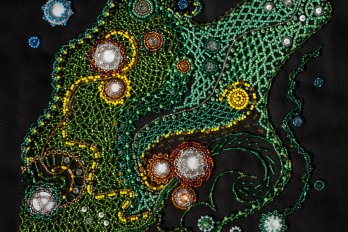On November 2, Edmonton’s Boot Scootin’ Boogie Dancehall was filled to capacity. Hundreds were there to vent their grievances—grievances stirred up by a series of speakers who lashed out at the federal government for everything from its habit of taking climate change seriously to what one person called its “creeping socialism.” MAGA (that is, Make Alberta Great Again) merchandise was sold, the Canadian flag was held upside down, and the CBC was roundly booed.
The rally was hosted by Wexit Alberta, a separatist group founded by Peter Downing that is calling for a referendum that would allow the province to break away from Canada. A former Mountie, Downing promised the packed room that his movement—now a federal political party—would excise “the parasite of eastern Canada off from our necks,” a sentiment finding new favour after the Liberal party was reelected without securing a single seat in Alberta or Saskatchewan. The Vote Wexit Facebook page today boasts over 250,000 members—according to the Canadian Press, that number went from 2,000 on the night of the election to nearly 160,000 by the following afternoon. On the same day, Alberta Premier Jason Kenney spoke of a conversation with Justin Trudeau in which he told the prime minister that the election results reflected a “profound sense of alienation that must be taken seriously. Many Albertans feel betrayed.”
If all this talk of western separation sounds familiar to some Canadians, that’s because they might have been around the last time it happened. In 1980, lawyer and political activist Doug Christie filled halls with angry Albertans under the auspices of the Western Canada Concept—a political party that would actually win a seat in the provincial legislature, in a 1982 by-election, before fading into irrelevance. Roger Epp, a professor at the University of Alberta who covered one of Christie’s meetings in November of that year, as a reporter for the Lethbridge Herald, says the similarities are striking. “I remember the three-syllable, Trump-style chant—‘free the West, free the West’—that rocked the building whenever the crowd was roused, as it was again and again,” he noted in a recent piece for the Globe and Mail. “Even now, I cannot recall that night without an involuntary tingle in my spine.”
Then, as now, Alberta was dealing with the consequences of an oversupplied global oil market—prices fell from $35 (US) per barrel in 1980 to less than $10 (US) per barrel by 1986—that would bring the province’s economy to its knees. Then, as now, the separatists were frustrated with a prime minister named Trudeau and the way his government treated their oil-and-gas industry. Then, as now, the separatists were led by a firebrand with conspicuous connections to the far right (Vice described Downing as a “right-wing conspiracy theorist” because of, among other things, his lobby group’s funding of a bulletin board that claimed current Prime Minister Trudeau was “normalizing pedophilia,” while Christie became known for defending neo-Nazis and holocaust deniers in court). And then, as now, the separatists had a premier who both fanned the flames of western alienation and talked up his ability to contain them.


The similarities are striking, but the differences are also worth our attention. As Epp noted, the separatist movement in the 1980s was a mostly homegrown phenomenon, and it had only print and radio at its disposal. The current iteration, amplified by social media, traffics in the familiar symbols of global populism, like yellow vests and MAGA hats, as well as many of the uglier ideas, like xenophobia, that those symbols stand for. “Aware or not of the darker tendencies of that populism,” Epp wrote, “it risks becoming the kindling for a bigger, more dangerous fire.”
That risk is real. Early last November, an Ipsos poll suggested that separatist sentiment in the Prairies had reached record highs. According to that data, 33 percent of Albertans and 27 percent of Saskatchewanians believe their province would be better off if it left Canada—according to some polls, that’s an increase of almost 10 percent from 2018 and nearly double the number in 2001. And, while it’s tempting to dismiss the movement, that’s one temptation Charles Adler, a popular western Canada radio host, says we need to avoid. “If it stays subterranean, we’ll be fine. But if it evolves—as Quebec separatism did, as separatist ideology does all over the world—to the mainstream? Then, Houston, we have a problem.”
Frustration with Ottawa is a foundational part of Alberta’s political culture. It was clear from the outset that federal politicians saw the west as a place to be exploited in any number of ways, a vision that was most famously articulated by John A. Macdonald’s National Policy, a series of tariffs that protected manufacturing sectors in Ontario and Quebec from US competition— building up industries in the east while opening the west (with the railroad and settlement) to create more customers for those industries. Frank Oliver, the publisher of Edmonton’s first newspaper and a federal cabinet minister, claimed back in 1885 that the federal government’s treatment of the west was “despotism as absolute, or more so, than that which curses Russia.”
And, while the rise and fall of the Western Canada Concept, in the early 1980s, was probably the most serious outbreak of western separatism to date, secessionist sentiments surged in the early 2000s with the Alberta Residents League, a group that lay the groundwork for the ideas still in circulation today. Those ideas were infamously articulated in the so-called Firewall Letter, co-authored in 2000 by a collection of conservative Albertans that included Stephen Harper. Demands included the province creating Alberta versions of the Canada Pension Plan and RCMP, collecting personal income tax, and taking full control of health care policy. The letter also pushed for Alberta to keep the billions that it allegedly “loses” to Ottawa in transfer payments. (The claim was that Alberta sent billions of dollars to Ottawa in taxes that weren’t spent on Albertans but instead handed away to other provinces.) While then premier Ralph Klein dismissed the idea of separating from Canada, he was happy to give the Firewall Letter proposals a hearing at his party’s 2003 annual general meeting, positioning himself as the reasonable voice.


That appears to be Kenney’s strategy too. Last November, in a keynote address in Red Deer, he argued that separation isn’t the answer to Alberta’s problems: “I do not understand how the solution to a campaign to landlock Alberta is to landlock ourselves voluntarily.” But he followed up by announcing that the province would strike a panel to explore a “Fair Deal” for Alberta, one focused on ideas central to the Firewall Letter. “We are going to be very bold in imagining every way that we can assert ourselves,” he said.
For a government with an economy-first approach, this is an odd strategy. After all, it was the Parti Québécois’s 1976 election and subsequent drive for a referendum on independence that helped shift economic power in Canada away from Montreal and toward Toronto. Hundreds of companies, including Sun Life Financial and the Bank of Montreal, moved their operations south. As former McGill professor Reuven Brenner told the Financial Timesin 2014, “Montreal never recovered—there is no financial sector in the city.”
And the impact of flirting with separation pales in comparison to what would be visited upon Alberta if it were to actually succeed in breaking away. Its ability to access tidewater would suddenly be mediated by a country it had just separated from. The province’s debt would grow, likely because it would be forced to take on a proportional share of the federal debt as a condition of secession. That additional burden could be measured in billions of dollars—and might have to be met, ironically, with the introduction of the sales tax Alberta politicians have resisted for so long. And the former province would be on its own when it comes time to deal with the costs associated with cleaning up after the oil sands, an amount that internal documents from the Alberta Energy Regulator suggested could be as high as $260 billion. (The regulator later called that figure a “worst-case scenario.”)
Perhaps most importantly, the current iteration of Alberta separatism fails to reckon with the resistance of Indigenous communities. “As chiefs, with our united voices and on behalf of our twenty-two member nations—with clear conscience—declare we are strongly opposed to the idea of separation from Canada,” Treaty 8 First Nations chiefs wrote in a joint statement. “Any process of separation which may take place without maintaining the true spirit and intent of our treaty, and without the consent of our member nations, would be contrary to constitutional and international law.” This is no small matter given that the treaties in question cover much of the province’s geography—including the oil sands.
But facts don’t seem to have the same influence that they used to, and the inherent irrationality of an idea—like, say, Brexit—is no guarantee that voters will reject it. Populism, at its core, is an inversion of Pierre Trudeau’s personal slogan of “reason over passion,” and explanations that appeal to the former have no purchase on the latter. Yes, Alberta has the highest household incomes in the country (at least as of the 2016 census), but that data tends to be a lagging indicator of what’s really happening in the economy—and it doesn’t account for the province’s high rates of suicide and personal insolvency. “All of that is interesting if you’re a policy wonk,” Adler says of efforts to point out the flaws inherent in Alberta separatism, “but as far as the people who are struggling go, it doesn’t mean anything to them.”

Last fall, a team of University of Alberta researchers talked to more than 600 people across the province as part of an ongoing project called Common Ground. According to Jared Wesley, a political-science professor and the principal investigator, it was an effort to uncover not what people believed or felt about separatist sentiments but what they thought other Albertans believed or felt—and to reveal the bounds of what is politically acceptable.
Perhaps the most important finding is that Wexit sympathizers have a great deal in common with residents from places like Wisconsin, which continues to deal with the collapse of its manufacturing industry, and West Virginia, which has been crushed economically by the cratering price of coal. “Your grandfather’s western alienation was about Alberta being held back,” says Wesley. “But what we’re hearing from folks in these focus groups is that they feel like they’re being left behind. That tells us that we shouldn’t be looking to lessons from previous generations of western Canadians for solutions here. We should be looking at what’s happening in coal country, the rust belt in the United States, and to a certain extent, what happened to Newfoundland with the closure of the cod fishery.”
That, he says, means economic initiatives alone won’t be enough to address the concerns that people have. “It’s not about positions or policies at this point. It’s all about anxieties and priorities.” In other words, it’s not enough to buy a pipeline and promise to put it into service when many Albertans don’t believe the government that bought it actually supports the industry. And, while Trudeau has turned performative apologies into a political art form, he hasn’t yet found a way to connect with Albertans. “If it was simply a shopping list of things, at least then the federal government could try to work out some sort of compromise,” says Roger Gibbins, a senior fellow at the Canada West Foundation and its president and CEO from 1998 to 2012. “But, when it’s a deeper cultural belief in the failure of the national government, it’s harder to get a grip on that.”


Gibbins, who has studied western alienation for decades, doesn’t think Albertans are ready to give up on Canada yet. Neither, it seems, does Kenney. “I believe that, in their heart of hearts, the vast majority of them are Canadian patriots,” he said during his Red Deer keynote address. Perhaps. But that didn’t stop the Fair Deal Panel his government launched from exploring a raft of policies, like the creation of an Alberta pension plan and the domestic collection of federal taxes, that could conceivably prepare the province to secede from confederation. The panel held at least seven town halls between mid-November and the end of January and, as of this writing, is due to deliver its report to the government by March 31. And, while Wesley thinks that town halls could be good safety valves for the anger coursing through Alberta’s body politic right now, the idea of holding referendums is much more fraught. “You run the risk of unleashing forces that you might not be able to control,” Wesley says. “David Cameron thought he had a pretty good finger on the pulse of his party, if not the rest of the country, when he decided to hold a referendum on Brexit.”
A referendum on Alberta’s relationship with the rest of the country feels practically inevitable at this point. But what makes the latest flare-up of Alberta’s separatist movement especially dangerous is the probability that its oil-and-gas industry will never recover to the level it was at back in 2014, when oil last traded above $100 (US) per barrel, much less chart new heights. Even OPEC sees demand for oil peaking in less than twenty years. “The fight in 1980 was about policy jurisdiction and the distribution of non-renewable resource wealth,” Epp writes. “The stakes were not so existential.” And, as places like West Virginia (which gave Donald Trump the largest share of the vote in any state in the 2016 election) have shown, when the stakes are high enough, anything can happen—including the previously unthinkable.






